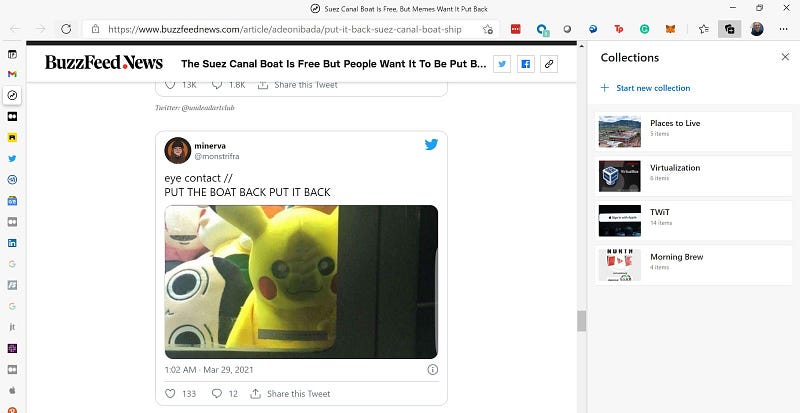Why I Transitioned from Chrome to Microsoft Edge and Love It
Written on
The Shift to Microsoft Edge
After over a decade of relying on Google Chrome, the world's leading web browser, I have made a decisive switch to Microsoft Edge, and I have no regrets. Chrome no longer occupies a space on my taskbar, marking a significant change in my browsing experience.
What began as a casual exploration of Edge's quirky name has transformed into a strong preference, especially after Microsoft adopted the Chromium engine. For years, I sought a way out of what I perceived as a demanding relationship with Chrome. While it excels in compatibility with web pages and offers a decent interface, it is notorious for consuming excessive resources, causing my system to overheat and slow down.
Chrome frequently crashed, and it seemed Google never optimized its resource management. Although countless users enjoy Chrome, I doubt many can maintain 20 or more open tabs without issues. My wife, who still clings to Chrome due to her reluctance to adapt to new software, often has multiple windows open, each filled with tabs. Her computer's fan rarely rests.
Microsoft did not create Edge to dethrone Chrome but to encourage users to move away from the outdated Internet Explorer, which still lurks within Windows 10. Edge marked a departure from the legacy compatibility focus that characterized earlier Microsoft browsers, allowing it to innovate and ultimately adopt the Chromium engine a few years later.
Since its 2008 debut, Chrome has evolved but remains a resource-intensive application. When Microsoft released the Chromium-based Edge in January 2020, I gradually transitioned all my online tasks to it.
One of the first things I noticed was Edge's superior resource management. Although it can still consume a lot of CPU cycles with multiple tabs open, it releases them more efficiently than Chrome when tabs are closed.
Over the past year, Microsoft has consistently improved Edge, enhancing stability and extension support. However, three recent updates have solidified my commitment to Edge, making it unlikely that I will revisit Chrome.
Collections: A Revolutionary Bookmarking System
The first game-changing feature is Collections, which offers a smarter, simpler method for organizing bookmarks. I haven't used traditional bookmarks in years, but Collections has proven to be both efficient and user-friendly.

Like bookmarks, Collections allow you to save and categorize web pages for later viewing. However, they are presented in a visually appealing vertical pane that remains open as you navigate. This feature was especially helpful during a recent appearance on TWiT, where I needed to keep track of multiple online articles.
Vertical Tabs: A Stress Reliever
Another transformative update is the introduction of Vertical Tabs. As someone who often juggles 15 or more open tabs, this feature has been a significant upgrade. I usually keep it as a collapsed ribbon on the left side of my browser, which expands when I hover over the tab bar. The previously overwhelming horizontal tab bar is no longer a source of stress.

Sleeping Tabs: A Power-Saving Feature
The most recent addition, Sleeping Tabs, has had a profound effect on my browsing experience. If you've been using Edge and have allowed automatic updates, you may have noticed grayed-out tabs indicating this feature in action.
Sleeping Tabs reduce resource usage by putting inactive web pages into a low-power state after five minutes, meaning they don’t consume system resources unnecessarily. Microsoft claims this can decrease memory usage by 32%. In practice, I've found Edge to be more stable, with my system fan rarely needing to kick into high gear while browsing.
Microsoft Edge's Market Position
Despite my satisfaction with Edge, I recognize its smaller footprint in the browser market. According to Statista, Edge holds only 3.41% of the global market share, while Chrome dominates with 65% (Safari follows with 19.14%). The loyalty to Chrome may stem from negative experiences with Internet Explorer or simply the familiarity users have with the Google ecosystem.
Nonetheless, Edge seamlessly integrates with Google services. I easily access my Google accounts from Edge without obstacles. The only adjustment I made to the default settings was changing the address bar's search engine from Bing to Google.
Ultimately, Microsoft Edge has become the browser I’ve always desired, and I see no reason to ever return to Google Chrome.
Chapter 2: Videos on the Shift from Chrome
The first video provides insights into why users should reconsider their reliance on Google Chrome, highlighting its limitations and encouraging a switch to alternative browsers.
The second video discusses the privacy concerns associated with Google Chrome and offers strategies for protecting online privacy, further supporting my decision to switch.